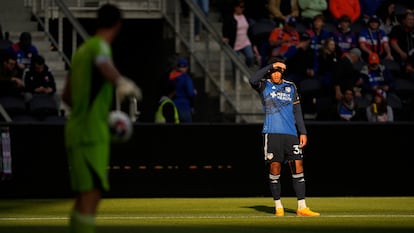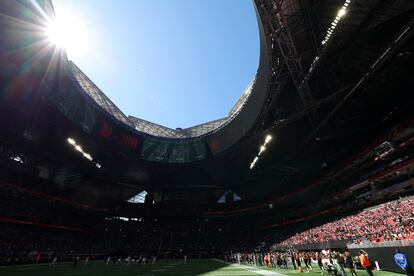Copa América kicks off in US under extreme heat alert: This is how climate change affects soccer
Conmebol has announced for the first time in its history a series of medical recommendations to prevent players suffering heat stroke during the tournament

When Argentina plays Canada this Thursday in the opening match of the 2024 Copa América, the United States will be in the middle of a heat wave that will affect more than 77 million people. The roof of Atlanta’s Mercedes-Benz Stadium, the venue for the match, will likely be closed to control the temperature inside in the face of the heat that Georgia’s capital city is experiencing.
Although June 20 marks the official start of summer in the northern hemisphere, temperatures in Atlanta are already much higher than during the hottest periods of the year half a century ago. In 1974, the highest temperature recorded in the city was 25ºC (77ºF); on Thursday, the forecast places the mercury at above 32ºC (89.6ºF).
In the scenario of an increasingly warming planet, the South American Football Confederation (Conmebol) has for the first time in its history issued a set of directives to address exertional heat stroke in soccer. With this announcement, it joins sports organizations such as FIFA and the English Premier League in implementing preventive measures in the face of extreme heat events.
In the announcement, published last Tuesday, Conmebol recognizes that “rising temperatures due to climate change poses significant threats to players” while the confederation highlighted “the organization’s commitment to player safety and climate awareness” in the face of “the severity of global warming.”
As Osvaldo Pangrazio, president of the Conmebol Medical Commission and director of its Anti-Doping Unit, explains, the guidelines, which were taken after analyzing “a record of the effects that heat can produce in some cities” seek to prevent “health problems such as hyperthermia, dehydration, and increased muscle injuries.” Their main concern is not the matches — which will be played in air-conditioned stadiums — but “the training sessions, both for the players and the referees.”
To prevent players from suffering heat stroke during the Copa América, Conmebol will allow them to request breaks throughout the tournament, Pangrazio explains. If required, players will be able to ask the referee for 90-second hydration stoppages. In addition, the doctor recommends the use of ice towels at half-time.

One of the first heat waves of the season
The current heat wave is expected to affect the Midwest and Northwest U.S. throughout this week. As of Tuesday morning, more than 77 million Americans were under extreme heat alerts. The U.S. National Weather Service (NWS) estimates that certain areas of the country, such as the Texas cities of Brownsville and Laredo, will exceed 41ºC (105.8ºF) over the weekend. In Atlanta, where the opening game will be played, temperatures on Saturday and Sunday will reach 36ºC (96.8ºF).
Heat waves in the U.S. have increased in both frequency and severity in recent years. In June 2021, western North America experienced a record heat wave that not only registered the highest temperatures in the region’s history, but also led to wildfires, the deaths of more than half a million animals, and severe damage to crops. The U.S. National Oceanic and Atmospheric Administration (NOAA) estimates that this extreme heat event caused damages valued at approximately $8 billion. A study published in the scientific journal Science Advances concluded that, since 1960, there have only been five more serious extreme heat waves.
This week’s weather event is not expected to be as intense as the one in 2021. However, high temperatures will most severely affect Arizona, New Mexico, Florida, Nevada, and Texas; the latter three states will host most of the Copa América games.
“The weather report for the beginning of the week indicates that many areas will experience a heat wave that is not going to last long, but it is going to be significant,” said Pangrazio. “We are monitoring that system so that team doctors can take the necessary measures.”

How does heat affect soccer?
“Heat always affects athletic performance,” notes Leslie Mabon, a professor of environmental systems at the Open University. The impact varies depending on the athlete’s physical condition, age, style of play, and role in the team.
Conmebol’s recommendations emphasize the prevention of heat stroke caused by exertion which, in the most severe instances, can cause death, even in young athletes. “The risk is greatest during training, in extreme heat conditions, especially in sports communities where athletes are encouraged to push themselves to the maximum,” says Mabon.
“When considering heat stress, we must take into account both the heat generated internally by physical activity and the external heat of the environment,” says S. Tony Wolf, assistant professor in the department of kinesiology at the University of Georgia.
In addition, he adds, is the impact of ambient humidity. “In order for sweat to cool us, it has to evaporate. In a very humid environment, sweat stays on the skin or drips off without evaporating, making it difficult to regulate body temperature.”

A sporting world adapting to the weather
Conmebol is not the only organization taking steps to integrate a response to the effects of climate change on soccer. FIFA, for example, indicates that a WetBulb Globe Temperature (WBGT) value above 32ºC (89.6ºF) constitutes an “extreme risk of thermal injury.”
This parameter for measuring heat, Wolf notes, is more comprehensive and gives a “more accurate picture of the total thermal environment and its impact on heat dissipation through sweat,” as it takes into account ambient temperature, humidity, solar radiation and air movement.
Under extreme heat conditions, FIFA suggests postponing the match or implementing hydration breaks every 30 minutes so that players can rest. This was the case in the game between Mexico and the Netherlands at the 2014 World Cup in Brazil, when referee Pedro Proença ordered the first hydration break in a FIFA competition due to the extreme heat in the stadium. Extreme temperatures were also the reason FIFA moved the Qatar 2022 World Cup from June to November.
The Premier League implemented similar measures in 2022, when the U.K.’s Met Office declared an extreme heat warning during a weekend round of fixtures. In response, the English top-flight implemented mandatory hydration breaks when the temperature exceeded 30ºC.
However, organizations such as the International Federation of Professional Footballers have criticized these measures as insufficient. The association claims that FIFA’s guidelines, with only one break per half, do not allow players to rest or hydrate adequately.
The debate underscores a sporting world in search of answers to climate change. “Some organizations, such as the International Cycling Union, have created guidelines based on the WBGT to limit or cancel events. However, many of these measures are not completely evidence-based,” Wolf notes. “We need more research efforts to better understand what environmental conditions lead to increased risk.”
Mabon, for his part, believes that preventive measures can be effective, although their usefulness is limited. For example, Conmebol recommends that soccer players acclimatize to the heat for two weeks before matches, but since the Copa América will be played in 14 different cities, temperatures and conditions will change depending on the time, day and location.
“There are ways to adapt, such as training at cooler times of the day, having cooling breaks, and playing early in the morning or late at night,” says the Open University environmental systems professor. “However, as the world gets warmer, there is a limit to how much adaptation is possible for the human body.”

Sign up for our weekly newsletter to get more English-language news coverage from EL PAÍS USA Edition
Tu suscripción se está usando en otro dispositivo
¿Quieres añadir otro usuario a tu suscripción?
Si continúas leyendo en este dispositivo, no se podrá leer en el otro.
FlechaTu suscripción se está usando en otro dispositivo y solo puedes acceder a EL PAÍS desde un dispositivo a la vez.
Si quieres compartir tu cuenta, cambia tu suscripción a la modalidad Premium, así podrás añadir otro usuario. Cada uno accederá con su propia cuenta de email, lo que os permitirá personalizar vuestra experiencia en EL PAÍS.
¿Tienes una suscripción de empresa? Accede aquí para contratar más cuentas.
En el caso de no saber quién está usando tu cuenta, te recomendamos cambiar tu contraseña aquí.
Si decides continuar compartiendo tu cuenta, este mensaje se mostrará en tu dispositivo y en el de la otra persona que está usando tu cuenta de forma indefinida, afectando a tu experiencia de lectura. Puedes consultar aquí los términos y condiciones de la suscripción digital.
More information
Archived In
Últimas noticias
There is as much life left to discover on planet Earth as that which is already known
Dozens presumed dead, around 100 injured in fire at Swiss Alps bar during New Year’s celebration
Is porn for women different from conventional porn? We spoke to those who make it
Cartagena de Indias is sinking: What can the city do to mitigate it?
Most viewed
- Reinhard Genzel, Nobel laureate in physics: ‘One-minute videos will never give you the truth’
- Sinaloa Cartel war is taking its toll on Los Chapitos
- David King, chemist: ‘There are scientists studying how to cool the planet; nobody should stop these experiments from happening’
- Oona Chaplin: ‘I told James Cameron that I was living in a treehouse and starting a permaculture project with a friend’
- The Interoceanic Train, the Mexican alternative to the Panama Canal










































